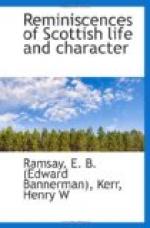a noble family had adopted those views, and carried
them out regardless of expense. The lady who had
been instrumental in getting up these musical services
was very anxious that a favourite female servant of
the family—a Presbyterian of the old school—should
have an opportunity of hearing them; accordingly, she
very kindly took her down to church in the carriage,
and on returning asked her what she thought of the
music, etc. “Ou, it’s verra bonny,
verra bonny; but oh, my lady, it’s an awfu’
way of spending the Sabbath.” The good
woman could only look upon the whole thing as a musical
performance. The organ was a great mark of distinction
between Episcopalian and Presbyterian places of worship.
I have heard of an old lady describing an Episcopalian
clergyman, without any idea of disrespect, in these
terms:—“Oh, he is a whistle-kirk minister.”
From an Australian correspondent I have an account
of the difference between an Episcopal minister and
a Presbyterian minister, as remarked by an old Scottish
lady of his acquaintance. Being asked in what
the difference was supposed to consist, after some
consideration she replied, “Weel, ye see, the
Presbyterian minister wears his sark under his coat,
the Episcopal minister wears his sark aboon his coat.”
Of late years, however, a spirit of greater tolerance
of such things has been growing up amongst us,—a
greater tolerance, I suspect, even of organs and liturgies.
In fact, we may say a new era has begun in Scotland
as to church architecture and church ornaments.
The use of stained glass in churches—forming
memorial windows for the departed[19], a free use of
crosses as architectural ornaments, and restoration
of ancient edifices, indicate a revolution of feeling
regarding this question. Beautiful and expensive
churches are rising everywhere, in connection with
various denominations. It is not long since the
building or repairing a new church, or the repairing
and adapting an old church, implied in Scotland simply
a production of the greatest possible degree of ugliness
and bad taste at the least possible expense, and certainly
never included any notion of ornament in the details.
Now, large sums are expended on places of worship,
without reference to creed. First-rate architects
are employed. Fine Gothic structures are produced.
The rebuilding of the Greyfriars’ Church, the
restoration of South Leith Church and of Glasgow Cathedral,
the very bold experiment of adopting a style little
known amongst us, the pure Lombard, in a church for
Dr. W.L. Alexander, on George IV. Bridge,
Edinburgh; the really splendid Free Churches, St.
Mary’s, in Albany Street, and the Barclay Church,
Bruntsfield, and many similar cases, mark the spirit
of the times regarding the application of what is
beautiful in art to the service of religion. One
might hope that changes such as these in the feelings,
tastes, and associations, would have a beneficial
effect in bringing the worshippers themselves into
a more genial spirit of forbearance with each other.




